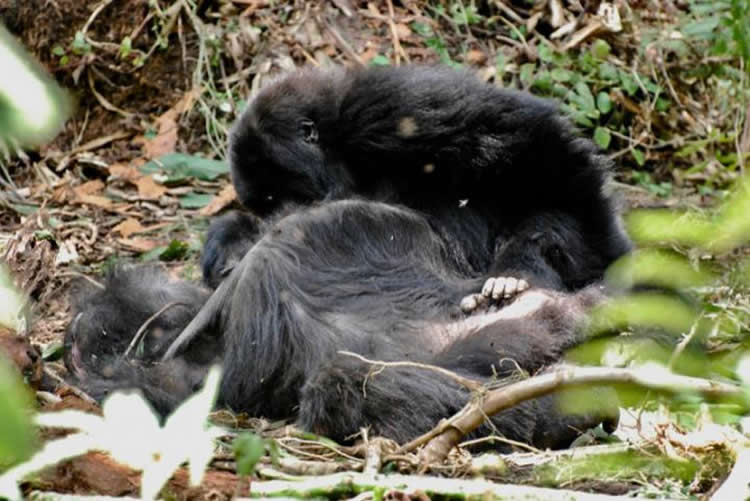Summary: Researchers observe grooming and mourning behaviors by gorillas towards others in their social groups who recently died. The study sheds light on how animals perceive and process death.
Source: PeerJ
It is now known that many animals exhibit unique behaviors around same-species corpses, ranging from removal of the bodies and burial among social insects to quiet attendance and caregiving among elephants and primates. Researchers in Rwanda and Democratic Republic of Congo have been able to take a close look at the behavioral responses to the deaths of three individuals — both known and unknown — in gorillas and have reported their findings in PeerJ.
Scientists from the Dian Fossey Gorilla Fund, the University of California Davis, Uppsala University, and the Congolese Institute for the Conservation of Nature observed and filmed the behavior of mountain gorillas around the corpses of a 35-year-old dominant adult male and a 38-year-old dominant adult female from the same social group living in Volcanoes National Park, Rwanda. Both individuals had died a few hours earlier of illnesses possibly linked to their advanced age. Researchers also studied the behavior of a group of Grauer’s gorillas who found the body of a recently deceased adult male in Kahuzi-Biega National Park, Democratic Republic of Congo.
Researchers predicted that more individuals would engage with the corpses of familiar members of their own group compared to the extra-group mature male and that individuals who shared close social relationships with the deceased would be the ones to spend the most time close to the body.
To the researcher’s surprise, the behavioral responses toward the corpses in all three cases were remarkably similar. In all three cases, animals typically sat close to the body and stared at it but they also sniffed, poked, groomed and licked it.

In the two mountain gorilla cases, individuals that shared close social relationships with the deceased were the ones who spent the most time in contact with the corpse. For example, a juvenile male who had established a close relationship with Titus, the dominant mountain gorilla silverback male, after his mother left the group, remained close and often in contact with the body for two days, and slept in the same nest with it. The juvenile son of Tuck, the deceased adult female, groomed the corpse and even tried suckling from it despite having already been weaned, a behavior that could indicate his distress near his mother’s body.
This work is not only of interest regarding how animals perceive and process death, but it also has important conservation implications. Close inspection of corpses can present a serious risk for disease transmission. Contacts between healthy individuals and infected corpses may be a major way through which diseases like Ebola, which have affected and killed thousands of gorillas in Central Africa, spread among gorillas.
Source:
PeerJ
Media Contacts:
Dr. Amy Porter – PeerJ
Image Source:
The image is Dian Fossey Gorilla Fund International (gorillafund.org).
Original Research: Open access
Porter A, Eckardt W, Vecellio V, Guschanski K, Niehoff PP, Ngobobo-As-Ibungu U, Nishuli Pekeyake R, Stoinski T, Caillaud D. 2019. “Behavioral responses around conspecific corpses in adult eastern gorillas (Gorilla beringei spp.) PeerJ 7:e6655 doi:10.7717/peerj.6655
Abstract
Behavioral responses around conspecific corpses in adult eastern gorillas (Gorilla beringei spp.)
Humans were once considered unique in having a concept of death but a growing number of observations of animal responses to dying and dead conspecifics suggests otherwise. Complex arrays of behaviors have been described ranging from corpse removal and burial among social insects to quiet attendance and caregiving among elephants and primates. Less frequently described, however, are behavioral responses of individuals from different age/sex classes or social position toward the death of conspecifics. We describe behavioral responses of mountain gorillas (Gorilla beringei beringei) to the deaths of a dominant silverback and a dominant adult female from the same social group in Volcanoes National Park in Rwanda and the responses of Grauer’s gorillas (Gorilla b. graueri) to the corpse of an extra-group silverback in Kahuzi-Biega National Park, Democratic Republic of Congo. In gorillas, interactions between groups or with a lone silverback often result in avoidance or aggression. We predicted that: (i) more individuals should interact with the corpses of same-group members than with the corpse of the extra-group silverback; (ii) adult females with infants should avoid the corpse of the extra-group silverback; and (iii) in the mountain gorilla cases, individuals that shared close social relationships with the dead individual should spend more time with the corpse than other individuals in the group. We used a combination of detailed qualitative reports, photos, and videos to describe all occurrences of affiliative/investigative and agonistic behaviors observed at the corpses. We observed similar responses toward the corpses of group and extra-group individuals. Animals in all three cases showed a variety of affiliative/investigative and agonistic behaviors directed to the corpses. Animals of all age/sex classes interacted with the corpses in affiliative/investigative ways but there was a notable absence of all adult females at the corpse of the extra-group silverback. In all three cases, we observed only silverbacks and blackbacks being agonistic around and/or toward the corpses. In the mountain gorilla cases, the individuals who spent the most time with the corpses were animals who shared close social relationships with the deceased. We emphasize the similarity in the behavioral responses around the corpses of group and extra-group individuals, and suggest that the behavioral responses were influenced in part by close social relationships between the deceased and certain group members and by a general curiosity about death. We further discuss the implications close interactions with corpses have for disease transmission within and between gorilla social groups.






